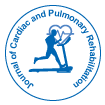Cardiovascular Risk Worldwide: A Growing Global Health Concern
Received: 04-Sep-2023 / Manuscript No. jcpr-23-114719 / Editor assigned: 06-Sep-2023 / PreQC No. jcpr-23-114719 (PQ) / Reviewed: 20-Sep-2023 / QC No. jcpr-23-114719 / Revised: 22-Sep-2023 / Manuscript No. jcpr-23-114719 (R) / Published Date: 29-Sep-2023 DOI: 10.4172/jcpr.1000219
Introduction
Cardiovascular diseases (CVDs) continue to be the leading cause of death worldwide, posing a significant global health challenge. The term "global cardiovascular risk" refers to the cumulative probability of an individual developing CVD over a specific period due to a combination of various risk factors. In this article, we will explore the concept of global cardiovascular risk, its contributing factors, and the importance of addressing this growing health concern on a global scale [1].
Defining global cardiovascular risk
Global cardiovascular risk encompasses the probability of developing various cardiovascular conditions, such as coronary artery disease, stroke, heart failure, and peripheral vascular diseases. This risk assessment considers both modifiable and non-modifiable risk factors, taking into account a person's age, gender, genetics, and lifestyle choices [2].
Understanding the risk factors
Age and gender: Advancing age is a non-modifiable risk factor, as the risk of CVD tends to increase with age. Gender also plays a role, with men typically at higher risk than premenopausal women. However, after menopause, a woman's risk begins to approach that of a man.
Genetics: Family history of CVD can significantly increase an individual's risk. Certain genetic factors can predispose someone to conditions like familial hypercholesterolemia, which leads to high cholesterol levels and an increased risk of heart disease.
High blood pressure (hypertension): Elevated blood pressure is a major modifiable risk factor for CVD. Uncontrolled hypertension can damage blood vessels and the heart over time.
High cholesterol levels: High levels of LDL (low-density lipoprotein) cholesterol, often referred to as "bad" cholesterol, can contribute to the buildup of plaque in the arteries, increasing the risk of heart disease [3].
Smoking: Tobacco use is a significant contributor to CVD. Smoking damages blood vessels, increases blood pressure, and reduces oxygen supply to the heart.
Diabetes: Uncontrolled diabetes can damage blood vessels and nerves, increasing the risk of heart disease and stroke.
Obesity: Excess body weight, especially around the abdomen, is associated with a higher risk of CVD.
Physical inactivity: A sedentary lifestyle can lead to obesity and increase the risk of CVD. Regular physical activity can help lower this risk [4].
Unhealthy diet: Diets high in saturated and trans fats, salt, and sugar can contribute to the development of CVD.
Stress: Chronic stress and poor stress management can indirectly affect cardiovascular health by influencing behaviors like overeating, smoking, and alcohol consumption.
Addressing global cardiovascular risk
Lifestyle modification: Encouraging individuals to adopt healthier lifestyles by promoting regular physical activity, a balanced diet, smoking cessation, and stress management is crucial.
Regular health checkups: Routine checkups can help identify and manage risk factors such as high blood pressure, cholesterol levels, and diabetes [5].
Medication: For individuals with high-risk factors or pre-existing conditions, medications may be necessary to control blood pressure, cholesterol levels, or diabetes [6].
Public health initiatives: Governments and healthcare organizations should invest in public health campaigns to raise awareness about CVD risk factors and prevention strategies.
Access to healthcare: Ensuring universal access to quality healthcare is essential to address CVD risk on a global scale, particularly in underserved regions [7].
Conclusion
Global cardiovascular risk is a complex interplay of various factors, both modifiable and non-modifiable. Recognizing and addressing this risk is crucial to reducing the burden of cardiovascular diseases worldwide. By promoting healthier lifestyles, improving access to healthcare, and conducting research to better understand CVD, we can work towards a world where fewer lives are affected by these devastating conditions. It is a global health challenge that requires a coordinated effort from individuals, healthcare professionals, policymakers, and society as a whole to mitigate its impact.
Acknowledgement
None
Conflict of Interest
None
References
- Komarov RN, Kleshchev PV (2020) [Current problems of simultaneous surgery of the aortic valve and ischaemic heart disease]. Angiol Sosud Khir 26: 168-174.
- Ashvin KN, Maruti H, Ibrahim ME, Jeswant D, Chee CH, et al. (2020) Surgical outcomes of absent pulmonary valve syndrome: An institutional experience. Ann Pediatr Cardiol 13: 212-219.
- Zahra H, Farhad SM, Mohammad V, Seyed ER, Somaieh M (2020) Fluid-structure interaction of blood flow around a vein valve. Bioimpacts 10: 169-175.
- Pradeep N (2021) Structural valve degeneration in the transcatheter mitral valve implantation era. J Card Surg 36: 4431-4433.
- Arnold SB, Henry FC (2021) Prosthetic Valve Endocarditis Diagnosis and Management- New Paradigm Shift Narratives. Clin Infect Dis 72: 1687-1692.
- Roland H, Francois R, Mathieu V, Jean N (2012) Valve replacement in children: a challenge for a whole life. Arch Cardiovasc Dis 105: 517-528.
- Asmeret GK, Gaetano B, Patricia C, Audrey D, Sandip S, et al. (2009) Current developments and future prospects for heart valve replacement therapy. J Biomed Mater Res B Appl Biomater 88: 290-303.
Indexed at, Google Scholar, Crossref
Indexed at, Google Scholar, Crossref
Indexed at, Google Scholar, Crossref
Indexed at, Google Scholar, Crossref
Indexed at, Google Scholar, Crossref
Indexed at, Google Scholar, Crossref
Citation: Patel P (2023) Cardiovascular Risk Worldwide: A Growing Global Health Concern. J Card Pulm Rehabi 7: 219. DOI: 10.4172/jcpr.1000219
Copyright: © 2023 Patel P. This is an open-access article distributed under the terms of the Creative Commons Attribution License, which permits unrestricted use, distribution, and reproduction in any medium, provided the original author and source are credited.
Share This Article
Open Access Journals
Article Tools
Article Usage
- Total views: 1052
- [From(publication date): 0-2023 - Mar 12, 2025]
- Breakdown by view type
- HTML page views: 946
- PDF downloads: 106
